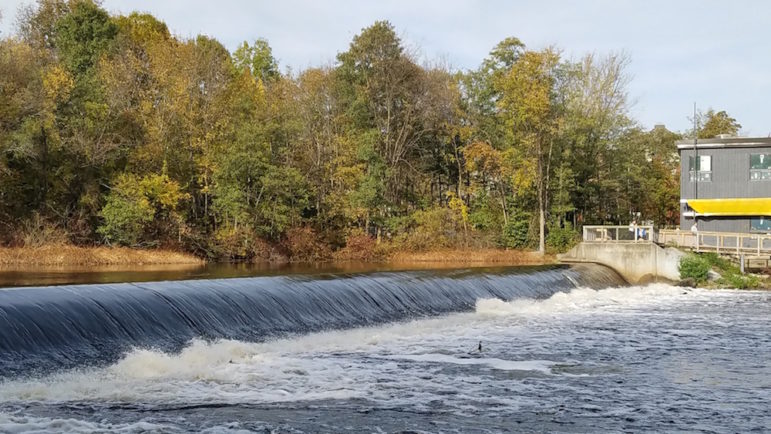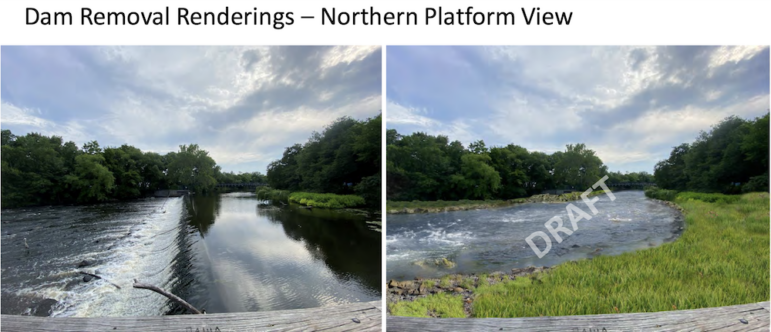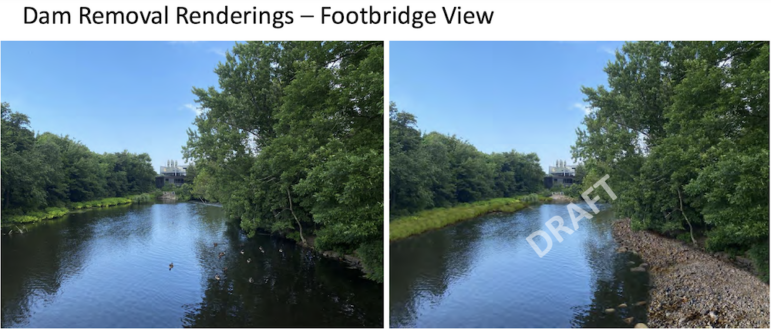
Charlie Breitrose The Watertown Dam near Watertown Square slows the flow of the Charles River. A group is advocating removing the dam.
The consultants examining the possible removal of the Watertown Dam presented their findings after studying the area near the dam over the Charles River just west of Watertown Square. The public can comment on the proposal until July 23.
The dam was discussed at a public meeting held on July 9 at the Watertown Library. Removal of the dam is being examined by the Department of Conservation and Recreation, and is supported by the Watertown City Council and the Charles River Watershed Association.
A dam of some sort has been in the same spot in Watertown since 1634, when one was built to power a grist mill. Prior to that, a fish weir had been made in that area by local Native Americans. The dam stopped being used to power mills in the early 1900s with the introduction of steam and electric powered machines. The dam suffered damage during Hurricane Diane in 1955, and was rebuilt in 1966. The fish ladder was added in 1972. The area behind the dam flooded after a storm in 2010.
The dam, which has a 180-foot concrete spillway and earth embankments on either side, is in fair condition, which is in the middle of the five condition classifications used by the State, according to Chad Cox of GZA GeoEnvironmental, the firm studying the dam.
“There are deficiencies but no structural deficiencies,” Cox said. “There are some uncertainties and there may be deficiencies that may occur under extreme load conditions.”
The hazard potential for the dam is significant, Cox said, which means if the dam fails it may cause loss of life and damage to homes, industrial or commercial facilities, secondary highways or railroads or “cause interruption of use or service of relatively important facilities.”
“Hazard potential is completely unrelated to the condition, the physical state the dam is in,” he said. “The hazard potential is the potential for downstream damage in the hypothetical event of a failure. It can be in good condition and be a high hazard dam because a lot of people live downstream from it.”
One of the main reasons cited for the removal of the dam is that it prevents fish and other species from migrating upstream. Even with the fish ladder, not all species can get past the dam, said Rex Gamble of GZA GeoEnvironmental.
“Historically, there have been lots of fish going from sea to land. There are records of Atlantic salmon all the way up to Eagle Brook in Wrentham,” Gamble said.
Fish currently found in the Charles River include Rainbow Smelt, American Eel, American Shad and two types of herring: Alewife and Blueback. A count of herring by the Division of Marine Fisheries in 2013-14 found that 300,000 herring attempted to migrate upstream.
Some of the attractions of the dam, Gamble said, are having the falls and the recreation area behind the dam, but that also is a potential hazard for boats going over the spillway.
If the dam is removed the area immediately behind the dam would change, but it would not be as noticeable farther upstream, Cox said.
“Because the dam is part of the river, and essentially extends across what was the river channel, it doesn’t have a large upstream impoundment (of water),” Cox said. “The visual change post removal would likely be much less dramatic than other dam removal scenarios. At the dam itself there would definitely be a change. Once you get past footbridge the change would be a lot more subtle.”

Gamble said no large mud flat would remain, as would be the case if a large pond formed behind the dam. Cox said there would not have to be major vegetation restoration because they anticipate seeds from plants in the area would be in the sediment and would start growing after the dam is removed.

To remove the dam, the work would be planned for a time of low water flow, and a time not critical to fish, Gamble said.
“Once we secure the site, and do any erosion control, we can divert the water from upstream to downstream so it doesn’t go over the spillway,” Gamble said. “We basically mechanically remove part of the dam. Once we have erosion control in place and the work is done, we let water flow back over the section of dam that was removed. We plant seeds, vegetation, so that it looks nice and is stable for future use.”
A video of the July 9 meeting can be seen below:
The slides from the meeting can be viewed by clicking here.
The deadline for public comment on the Watertown Dam project is July 23. Comments can be submitted at https://www.mass.gov/forms/dcr-public-comments